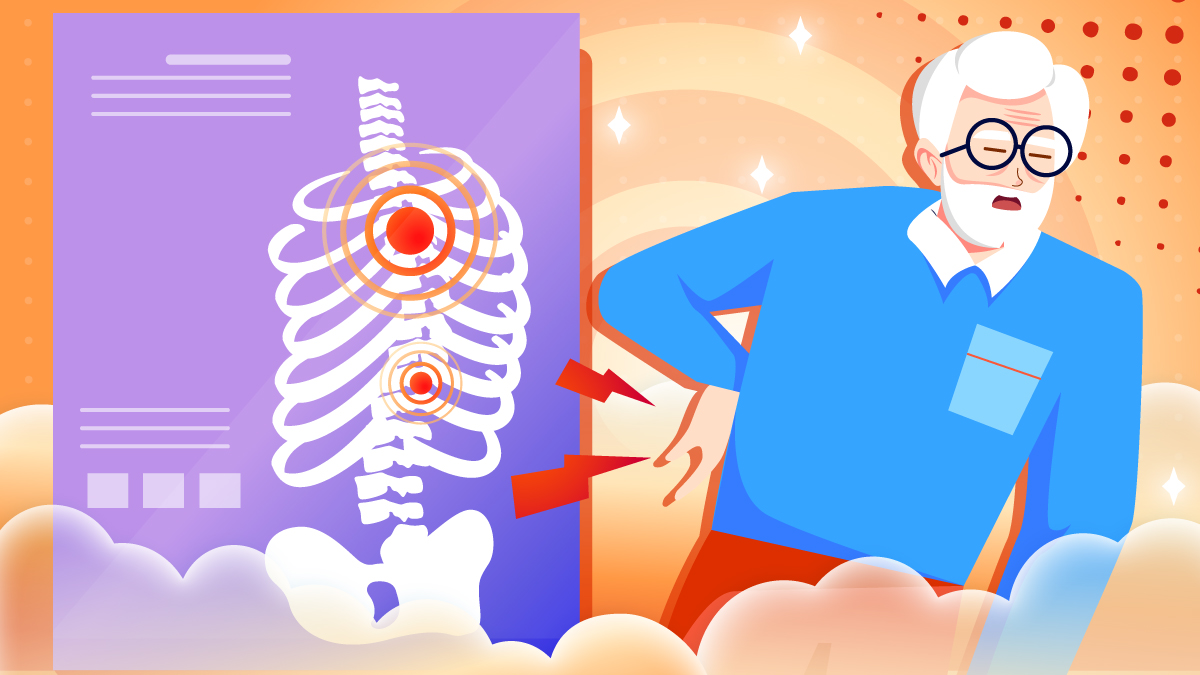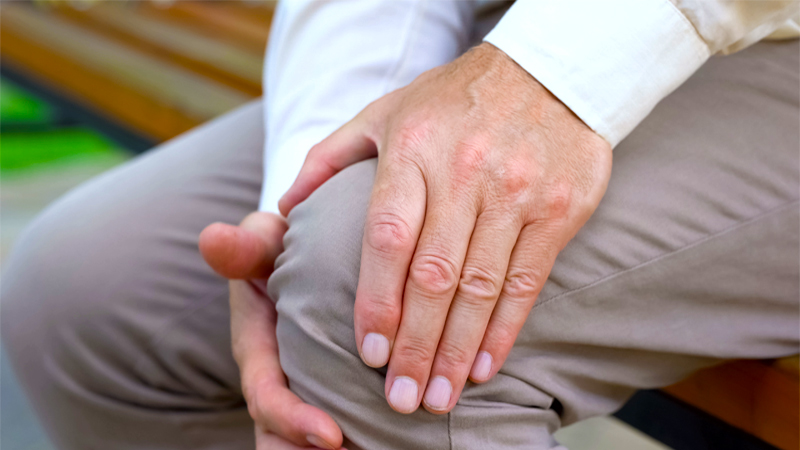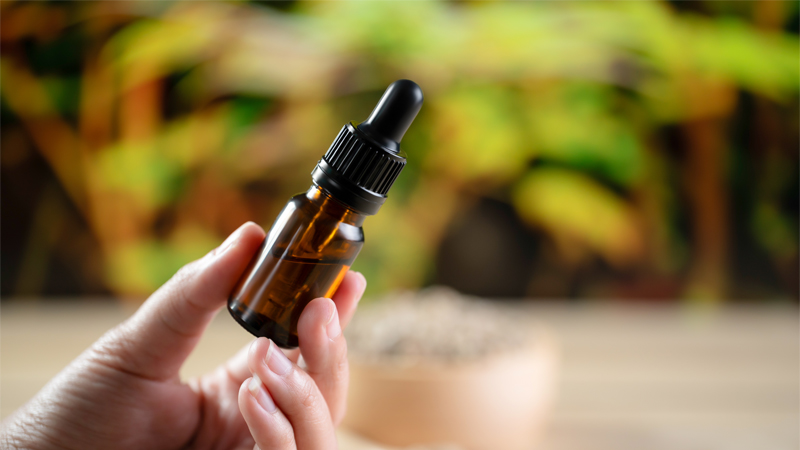CBD for Osteoporosis: Effectiveness & Dosage Guide

According to the latest research, CBD might be able to stop the progression of osteoporosis and protect the bones against losing density.
It’s estimated that over 200 million people suffer from osteoporosis around the world (1).
As reported by the International Osteoporosis Foundation, osteoporosis is responsible for a frightening number of 8.9 million bone fractures. In other words, there’s an osteoporotic fracture roughly every three seconds (2).
Some people call osteoporosis a “silent disease,” because many people don’t realize they have this condition until a fracture occurs.
In this article, we discuss current treatment for osteoporosis and explain how CBD may improve bone health and help with the disease in general.
What is Osteoporosis?
Osteoporosis translates into “porous bones.” It causes the bones to become fragile and puts those affected in a higher danger of fractures.
As the bones lose their density, even a minor bump or fall may lead to a serious injury.
Although the disease is more common in women, men can also be affected.
The main worry people have when suspecting osteoporosis is the high chance of a fracture — which is a complete or partial break in the bone.
Around 50% of women and 20% of men over 50s have suffered from an osteoporosis-related fracture in their life.
The most common bones affected by osteoporosis include the wrists, hips, and spine. Fractures and breaks can cause chronic problems with mobility.
What Causes Osteoporosis?

Osteoporosis can have many triggers, including nutritional deficiencies or hormonal imbalances. It’s also caused by the normal degeneration of the bone, which happens in every individual.
Human bones are broken down and repeatedly regenerate throughout life in a process called bone remodeling. The loss of bone mass occurs when the bone begins to break down at a faster rate than it gets replaced.
In the end, the bones lose calcium faster than they can rebuild it — losing density. In women, the loss of bone mass can speed up after menopause.
Certain medical disorders and illnesses can increase the risk of bone breakdown, including Cushing’s syndrome, kidney disease, and overactive thyroid.
While osteoporosis can’t be completely reversed, it can be significantly slowed down. One of the first things you can do is introduce lifestyle changes, including supplementation with calcium and vitamin D. Alcohol avoidance is also recommended, as well as reducing the amount of caffeine.
Foods and drinks that could potentially increase bone density include:
- Raw milk (not the pasteurized, UHT milk you can find in most grocery stores)
- Broccoli
- Cauliflower
- Fatty fish
- Grass-fed beef
- Maturing cheese
- Leafy green vegetables
- Yogurt
On top of healthy eating habits, you should also incorporate exercise into your daily routine to strengthen the bones.
Helpful exercise options include fast walking, step aerobics, dancing, racquet sport, or climbing stairs.
Living with Osteoporosis
Aging is one of the major risk factors for osteoporosis. Low bone mass increases the likelihood of a severe injury, such as a broken or fractured wrist, hip, or spine.
Individuals in high-risk groups should make sure their home is safe by removing clutter from the walkways and stairs; doing so should prevent falls. Non-slip mats in the bathroom and adhesives help ensure rugs remain firm on the ground.
Conventional Treatments for Osteoporosis (High Risk)
On top of the aforementioned lifestyle changes, a doctor may prescribe certain medications for osteoporosis. There’s a range of prescription drugs that may slow down bone degeneration.
This class of drugs is known as bisphosphonates and is better known under their trade names Boniva, Zometa, and Actonel.
Unfortunately, bisphosphonates demonstrate a low level of efficacy. This family of drugs can also lead to severe side effects, such as skin rash, low calcium in the blood, atypical femur fractures, and esophageal ulcers.
They may also cause pain in the joints, bones, and muscles. You can try CBD to counter some of these side effects.
Speaking of which, let’s elaborate on the potential benefits of CBD for osteoporosis.
CBD for Osteoporosis: How Does It Work?
When you try to figure out the number of diseases where the dysfunctional endocannabinoid system (ECS) is engaged, the list seems to have no end.
After fibromyalgia, diabetes type 1, migraines, irritable bowel syndrome, PTSD, and accelerated neurodegeneration, scientists have outlined another disease that can be affected by clinical endocannabinoid deficiencies (CECD) (3).
As you may guess, it’s osteoporosis.
The ECS is involved in maintaining homeostasis (biological balance) between all other systems and organs throughout the body — including bone density.
While daily stressors can negatively impact bone health, the ECS balances that state by facilitating the bone remodeling process.
According to a 2011 study posted by the British Journal of Pharmacology, fatty acid amides (FAA) interact with the body’s cannabinoid receptors and speed up bone regeneration (4).
The benefits of using CBD for osteoporosis include:
- The improved density of bones
- Reduced pain and inflammation
- Hormonal balance support
- Pain relief from bone fractures
Here’s how it happens.
CBD May Improve Bone Density
Research suggests that CBD is able to enhance the growth and strengthening of bones through improved osteoblast formation (5).
Scientists believe that osteoclasts — the cells responsible for breaking down the bones — contain a receptor that speeds up the loss of bone density. This receptor is called GPR55 and CBD has been shown to inhibit its activation, weakening osteoclast activity.
Furthermore, in a recent Israeli study, mice were administered CBD or a combination of CBD and THC. The authors found that CBD alone significantly boosted the healing of fractures and increased bone strength and toughness by accelerating Lysyl Hydroxylase — an enzyme responsible for bone regeneration.
These studies have provided us with a better understanding of how CBD affects bone health, opening new avenues for alternative osteoporosis treatments.
CBD Reduces Pain & Inflammation
Numerous studies have shown that CBD has remarkable anti-inflammatory properties, which can be useful in reducing pain and speeding up the healing of wounds and fractures.
People have long been using CBD for chronic pain as a non-addictive alternative to prescription painkillers (6).
Many patients have reported ditching their prescription pain pills in favor of CBD oil, with evidence that it can help ease headaches, mental health problems, insomnia, joint pain and arthritis, and other chronic symptoms.
Recommended Product: Royal CBD Oil
| Type of CBD | Full Spectrum |
| Total CBD Content | 250 mg – 2500 mg |
| Potency | 8.3 – 83.3 mg/mL |
| Flavors | Unflavored, Berry, Vanilla, Mint |
| THC Content | < 0.3 % |
CBD Dosage: How Much CBD Oil Should I Take?

The core principle of using CBD for osteoporosis is to start low and don’t rush to too high doses if you don’t see the results right away. CBD is the modulator of the ECS, so it may take time until it manages to level your endocannabinoid deficiencies.
Since products vary in terms of potencies and formulations, make sure to read the label of the specific product for dosage instructions.
Osteoporosis is one of the conditions where the benefits may take several months before you notice any change. We recommend starting out with a moderate dosage based on your weight.
Most people start with 1–5 mg of CBD per pound. You can keep a log or journal where you will write down how you feel after a single dose and after a specific period of supplementation (e.g. a week or month).
Is CBD Safe?
CBD is safe and well-tolerated by humans — even at very high doses.
Studies have found that even doses as high as 1,500 mg used for several weeks didn’t result in any serious side effects (7).
The WHO has stated that CBD oil, in its pure form, doesn’t pose a threat to one’s health or life, nor does it have the potential for abuse.
That being said, if you have underlying medical conditions, or using any prescription medications, you should always consult your doctor before buying CBD for osteoporosis.
CBD may interact with certain medications, leading to side effects that wouldn’t have occurred if you took both substances separately.
Speaking with your doctor will help you establish a safe routine and dosage for CBD and your medication.
Osteoporosis FAQ
Here are some of the most frequently asked questions about using CBD for osteoporosis.
What are the symptoms of osteoporosis?
Osteoporosis doesn’t have any specific symptoms before you get an actual bone fracture. There are other symptoms, but they can be difficult to notice.
Other signs of osteoporosis include:
- Loss of height
- Lowered grip strength
- Stooped posture
- Collapsed or fractured vertebra
- Back pain
Can menopause cause osteoporosis?
Osteoporosis is characterized by reduced bone density and a thinning of the cortical bone. This causes the bones to become spongy. Menopause is one of the main triggers of osteoporosis in women.
The regular cycle of bone regeneration involves breaking down the bone tissue and replenishing it; the process fluctuates on both a daily and monthly basis, affected by factors such as season, time of day, and diet.
Specialized cells within the bones — known as osteoblasts and osteoclast — play an essential role in these fluctuations in healthy bones. From adolescence to adulthood, bone formation outweighs their breakdown.
By the time a person has finished adolescence, bone growth should be completed. We usually achieve peak bone mass during our mid to late 20s.
The sex hormones estrogen and testosterone affect our body’s ability to maintain healthy bones in both men and women.
During menopause, estrogen levels drop, causing hormonal balances and a loss of control over bone density. This, in turn, results in an acceleration of bone mass loss. Women can lose up to 10% of their total bone mass during the first five years of this period.
What are the common risk factors for osteoporosis?
Some people are at a higher risk of developing osteoporosis than others. The common risk factors for losing bone density include:
- Vitamin D deficiency
- Obesity
- Early menopause
- Age
- Lack of exercise
- Calcium synthesis
- Alcohol intake
- Previous bone fractures
- Medications
- Medical conditions
- A family history of osteoporosis
- Smoking cigarettes
- Conditions that lower the absorption of nutrients
How is osteoporosis diagnosed?
The bone density scan yields a T-Score and Z-score; these scores are used to determine whether you’re at risk of developing a structure and whether a further diagnosis is needed.
The World Health Organization explains what T-Score says about your bone health:
- – 1.0 or above is normal bone density
- Between -1.0 and -2.5 means you may have osteopenia (low bone density)
- -2.5 or below is indicative of osteoporosis.
The following tests can also be conducted to figure out if the injury or fractures stem from osteoporosis:
- Bone X-Ray: bone X-rays should provide an image of bones that help in the diagnosis of fractured bones, which are sometimes a consequence of undiagnosed osteoporosis.
- CT Scan: this scan of the spine is used to evaluate alignment and fractures. It can be used to determine bone density and assess the likelihood of vertebral fractures.
- Magnetic Resonance Imaging (MRI): An MRI scan is used to diagnose vertebral fractures for evidence of underlying conditions, such as arthritis or cancer, and to determine the time at which the fracture occurred.
What are other natural treatments for osteoporosis besides CBD?
Depending on the severity of your osteoporosis and the risk of a bone fracture, your doctor may recommend lifestyle modifications to improve your bone density and restore homeostasis throughout the body.
Lifestyle modifications can also be used as a method of prevention when it comes to osteoporosis. By taking the proper amount of nutrients supporting bone density, you can delay the onset of the condition — or completely prevent it.
You can implement the following changes in your life:
- Limit the number of carbohydrates, seed oils, and processed food in your diet. Increase your consumption of grass-fed beef, fatty fish, organic fruit, and vegetables.
- Avoid smoking, and if you do smoke — quit it.
- Reduce alcohol intake
- Lift weights and run in intervals
- Provide your body with sufficient amounts of vitamin D and K2MK7 to support proper calcium synthesis in your bones.
Final Thoughts on Using CBD for Osteoporosis
Osteoporosis can take a serious toll on one’s quality of life. As a debilitating disease, it causes bone fractures and breaking — having a significant effect on one’s mobility.
While there’s no cure for osteoporosis, current evidence shows that CBD may be a promising treatment for this condition by relieving pain, increasing bone density, and slowing down the progression of the disease.
Based on today’s state of knowledge, CBD is seen as a safe, effective, and natural remedy for osteoporosis.
Sources:
- Sözen, T., Özışık, L., & Başaran, N. Ç. (2017). An overview and management of osteoporosis. European journal of rheumatology, 4(1), 46–56. [1]
- Giesser B. S. (2015). Exercise in the management of persons with multiple sclerosis. Therapeutic advances in neurological disorders, 8(3), 123–130. https://doi.org/10.1177/1756285615576663
- Russo E. B. (2016). Clinical Endocannabinoid Deficiency Reconsidered: Current Research Supports the Theory in Migraine, Fibromyalgia, Irritable Bowel, and Other Treatment-Resistant Syndromes. Cannabis and cannabinoid research, 1(1), 154–165. [2]
- Bab, I., Smoum, R., Bradshaw, H., & Mechoulam, R. (2011). Skeletal lipidomics: regulation of bone metabolism by fatty acid amide family. British journal of pharmacology, 163(7), 1441–1446. https://doi.org/10.1111/j.1476-5381.2011.01474.x
- Idris A. I. (2010). Cannabinoid receptors as target for treatment of osteoporosis: a tale of two therapies. Current neuropharmacology, 8(3), 243–253. [3]
- Baron, E. P., Lucas, P., Eades, J., & Hogue, O. (2018). Patterns of medicinal cannabis use, strain analysis, and substitution effect among patients with migraine, headache, arthritis, and chronic pain in a medicinal cannabis cohort. The journal of headache and pain, 19(1), 37. [4]
- Iffland, K., & Grotenhermen, F. (2017). An Update on Safety and Side Effects of Cannabidiol: A Review of Clinical Data and Relevant Animal Studies. Cannabis and cannabinoid research, 2(1), 139–154. [5]